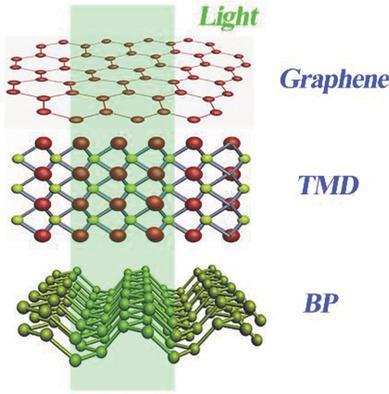当前位置:
X-MOL 学术
›
Adv. Opt. Mater.
›
论文详情
Our official English website, www.x-mol.net, welcomes your feedback! (Note: you will need to create a separate account there.)
Recent Advances in Optoelectronic Devices Based on 2D Materials and Their Heterostructures
Advanced Optical Materials ( IF 9 ) Pub Date : 2018-08-28 , DOI: 10.1002/adom.201800441 Jinbing Cheng 1 , Chunlan Wang 2 , Xuming Zou 3 , Lei Liao 1, 3
Advanced Optical Materials ( IF 9 ) Pub Date : 2018-08-28 , DOI: 10.1002/adom.201800441 Jinbing Cheng 1 , Chunlan Wang 2 , Xuming Zou 3 , Lei Liao 1, 3
Affiliation

|
2D materials, such as graphene, transition metal dichalcogenides, and black phosphorus, have become the most potential semiconductor materials in the field of optoelectronic devices due to their extraordinary properties. Owing to the layer‐dependent and appropriately sized bandgaps, photodetectors based on various 2D materials are designed and manufactured rationally. Utilizing the unique properties of 2D materials, many surprising physical phenomena of junctions based on 2D materials can be obtained after different 2D materials are stacked together. This makes heterojunctions more popular than 2D materials themselves, and the design of 2D materials for human beings is easier than ever. In this review, recent progress in optoelectronic applications based on 2D materials and their heterojunctions is summarized and discussed.
中文翻译:

基于二维材料及其异质结构的光电器件的最新进展
二维材料,例如石墨烯,过渡金属二卤化物和黑磷,由于其非凡的性能,已成为光电器件领域最有潜力的半导体材料。由于取决于层且具有适当大小的带隙,因此合理地设计和制造了基于各种2D材料的光电探测器。利用2D材料的独特特性,在将不同的2D材料堆叠在一起后,可以获得基于2D材料的结的许多令人惊讶的物理现象。这使得异质结比2D材料本身更受欢迎,并且人类2D材料的设计比以往任何时候都容易。在这篇综述中,总结并讨论了基于2D材料及其异质结的光电应用的最新进展。
更新日期:2018-08-28
中文翻译:

基于二维材料及其异质结构的光电器件的最新进展
二维材料,例如石墨烯,过渡金属二卤化物和黑磷,由于其非凡的性能,已成为光电器件领域最有潜力的半导体材料。由于取决于层且具有适当大小的带隙,因此合理地设计和制造了基于各种2D材料的光电探测器。利用2D材料的独特特性,在将不同的2D材料堆叠在一起后,可以获得基于2D材料的结的许多令人惊讶的物理现象。这使得异质结比2D材料本身更受欢迎,并且人类2D材料的设计比以往任何时候都容易。在这篇综述中,总结并讨论了基于2D材料及其异质结的光电应用的最新进展。



























 京公网安备 11010802027423号
京公网安备 11010802027423号